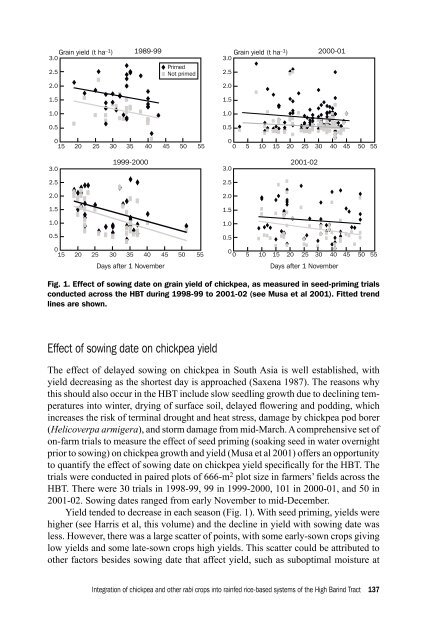Download (2461kB) - University of Greenwich
Download (2461kB) - University of Greenwich
Download (2461kB) - University of Greenwich
- No tags were found...
You also want an ePaper? Increase the reach of your titles
YUMPU automatically turns print PDFs into web optimized ePapers that Google loves.
Grain yield (t ha –1 )3.02.51989-99PrimedNot primedGrain yield (t ha –1 )3.02.52000-012.02.01.51.51.01.00.50.5015 20 25 30 35 40 45 50 5500 5 10 15 20 25 30 40 45 50 553.01999-20003.02001-022.52.52.02.01.51.51.01.00.5015 20 25 30 35 40 45 50 55Days after 1 November0.50 0 5 10 15 20 25 30 40 45 50 55Days after 1 NovemberFig. 1. Effect <strong>of</strong> sowing date on grain yield <strong>of</strong> chickpea, as measured in seed-priming trialsconducted across the HBT during 1998-99 to 2001-02 (see Musa et al 2001). Fitted trendlines are shown.Effect <strong>of</strong> sowing date on chickpea yieldThe effect <strong>of</strong> delayed sowing on chickpea in South Asia is well established, withyield decreasing as the shortest day is approached (Saxena 1987). The reasons whythis should also occur in the HBT include slow seedling growth due to declining temperaturesinto winter, drying <strong>of</strong> surface soil, delayed flowering and podding, whichincreases the risk <strong>of</strong> terminal drought and heat stress, damage by chickpea pod borer(Helicoverpa armigera), and storm damage from mid-March. A comprehensive set <strong>of</strong>on-farm trials to measure the effect <strong>of</strong> seed priming (soaking seed in water overnightprior to sowing) on chickpea growth and yield (Musa et al 2001) <strong>of</strong>fers an opportunityto quantify the effect <strong>of</strong> sowing date on chickpea yield specifically for the HBT. Thetrials were conducted in paired plots <strong>of</strong> 666-m 2 plot size in farmers’ fields across theHBT. There were 30 trials in 1998-99, 99 in 1999-2000, 101 in 2000-01, and 50 in2001-02. Sowing dates ranged from early November to mid-December.Yield tended to decrease in each season (Fig. 1). With seed priming, yields werehigher (see Harris et al, this volume) and the decline in yield with sowing date wasless. However, there was a large scatter <strong>of</strong> points, with some early-sown crops givinglow yields and some late-sown crops high yields. This scatter could be attributed toother factors besides sowing date that affect yield, such as suboptimal moisture atIntegration <strong>of</strong> chickpea and other rabi crops into rainfed rice-based systems <strong>of</strong> the High Barind Tract 137
















